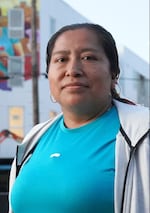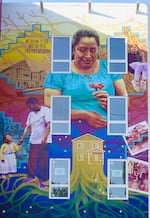The Mexican Revolution was a pivotal period that saw Mexico shift from a dictatorship to a constitutional republic. And women soldiers known as Las Adelitas played an important role often as combatants and at times as commanders.
Now they are the namesakes of a new affordable housing project in Northeast Portland’s Cully neighborhood.
“Las Adelitas to me represents a place of empowerment, a place of rebirth, a place of passion and success for something positive,” says Ernesto Fonseca, CEO of Hacienda CDC, the real estate developer of the project.
The building stands at the corner of Northeast Killingsworth Street and Cully Boulevard and officially opened its doors in late 2022.
On the side, a large mural celebrates the Cully neighborhood.

The mural "Together We Bloom" by artist Michelle Angela Ortiz is illuminated by the lights from Las Adelitas, an affordable housing project in northeast Portland.
Courtesy Hacienda CDC
“This mural had to send the message that we’re here, and this is who we are as Latinos, as brown people, as people of color,” Fonseca says.
Cully remains one of the more affordable and diverse neighborhoods in Portland, according to Living Cully, a coalition consisting of community outreach groups like Hacienda CDC, Habitat for Humanity, Verde, and the Native American Youth and Family Center (NAYA).
The real estate site Redfin in April released a survey stating that Portland’s asking rents were up 40% year-over-year from 2021.
Residents like Olga Tunay are worried about rising rental prices.
“To have a place that you can live in for $1,000 a month that is older than newer homes now can cause some problems,” Tunay says. “My own daughter was diagnosed with asthma and because the materials in our home are holding onto a lot of humidity, they’re just not up to par with the newer buildings.”

Cully resident Olga Tunay in front of the mural depicting her likeness at Las Adelitas
Courtesy Michelle Angela Ortiz
In 2019, the Oregon Housing and Community Services Department set a goal to build up to 25,000 affordable housing units by 2024.
Earlier this month, OHCS released a progress report stating that it is on track to reach its mark, having built more than 20,000 units, including the 142 apartments at Las Adelitas.
Investing in a neighborhood
Las Adelitas sits on land that once housed the Sugar Shack strip club. In 2015, Hacienda CDC, Habitat for Humanity and Verde owned the property together. They aimed to develop the land into a commercial property space.
But three years later, in 2018, Hacienda CDC took full ownership with the goal of creating affordable residential space instead.
“Housing is the first asset that families can own and is the most reachable. It is the one dream that families and individuals still can think about,” says Fonseca.
After four years of hard work and planning, Fonseca’s dream to build affordable housing for his community became a reality earlier this year.
Now he just needed the mural; something that could unite the community and give a sense of pride.
“What we wanted to do was to stitch a number of different little stories within this mural that were telling this story of Cully,” he says.
Fonseca worked with Portland Street Art Alliance and selected muralist Michelle Ortiz.
“Michelle comes also from the immigrant community herself and really understands our community, in every way that you can think of,” he says.

In this photo provided by Michelle Angela Ortiz, Ortiz, left, stands next to the Cully residents she depicted in her mural, "Together We Bloom," at Last Adelitas in Northeast Portland.
Courtesy Michelle Angela Ortiz
As part of the project, Ortiz spoke with Cully residents, including Tunay, to learn what they would want to put on their mural.
“We’re all trying to find a better place for our families and for our families to thrive. And that’s what I got from speaking with these women,” she says.
Ortiz placed Tunay right in the center of the large outdoor painting. She painted members of Cully’s BIPOC communities in bright colors ranging from orange and blue, evoking a sense of warmth and unity.
Ortiz envisioned the people as branches on what she calls a tree of life — her nod to Cully neighborhood stories.
“Even in the midst of darkness, there’s still space for light and growth. So you see these really vibrant roots at the very bottom of the mural,” Ortiz says.
At the center of that tree is Olga Tunay.
Tunay came to California from Guatemala in 2008. She moved to Oregon in 2011 and eventually settled in Cully, where she stays active in the community.
“There’s a clinic nearby. There’s a stop for the public transport for the bus. And I’m able to send my kids to school nearby,” Tunay says.
“I never thought I would see myself in the mural, but to see myself there is very inspiring. I hope I will inspire my daughters,” she says. “They’re already so excited saying, ‘Look, look, it’s my mom!’”
Ortiz titled the mural “Together We Bloom” after a poem she received from another Cully resident, Lizet Molina.
“The last words of the poem are ‘We belong to you and you belong to us and together we bloom.’” Ortiz says. “And so this concept in her poem, which she speaks of finding home away from a home. … That was really fundamental and really important to her.”
Molina wrote the poem as a way to express her love for Cully and its community. For her, Cully is more than just a place to live and raise her family.
Now, seeing her words immortalized on a large building for everyone to see, she hopes that whenever people pass Las Adelitas, they see a little bit of themselves in the mural.
“I hope that they can see that we all belong together and that we give life to this neighborhood, to this community.”

Artist Michelle Angela Ortiz's mural "Together We Bloom" adorns the walls of Las Adelitas, an affordable housing project in Portland's Cully neighborhood.
Courtesy Michelle Angela Ortiz
Editor’s note: This story has been updated to clarify that the OHCS report was released in December 2022.


